Recently a mother posted on my Facebook group, desperate for advice. She homeschools her kids and was trying to stick to a whole food plant-based diet but spending 4-5 hours a day in the kitchen was just not working!
She was flooded with great advice from the pros. I’m not talking about dieticians here. I’m talking about the real pros in this area: busy moms with hungry kids who are making a healthy diet a priority without letting it eat up all their time.
Combining my best time-saving hacks in the kitchen with the advice pooled from these wise moms gives you more opportunity to take what fits your lifestyle and leave the rest.
First, Know This
Cooking real food takes longer than hitting the drive-thru or buying frozen pizza. It just does! So set your expectations accordingly.
If you’ve been saving time through grabbing processed convenience foods, you’re not alone! Close to 50 million Americans used Lunchables last year. Convenience tempts us all, but we tend to only see the convenience that the food companies are selling, and it comes with an awful price for our health and for the planet. We are less well-versed in how to make a healthy diet more convenient in the day-to-day. That’s why we’ve got to help each other out!
It will be an adjustment to move towards preparing real food. Don’t despair though, there are lots of hacks to give you the most payback for your time in the kitchen.
Be Wise
No mom does all this stuff. It may be that just choosing one or two out of the list will make a real difference in your home. So consider your own situation and strengths when you consider these tips.
Plenty of us just muddle through and feed our family plants, figuring out as we go and that’s perfectly fine! These are just some shortcuts to consider.
1. Set aside a block of time on the weekend
It may never feel convenient to devote time to meal prep, but scheduling it and making it a regular thing will take the pressure off those hectic weekday mornings and evenings.
Increase your productivity further: Set a timer and just bust out as much you can in that time and call it good. That will keep you from procrastinating meal prep with the thought that it will take “forever,” and it’ll keep you focused and hustling for the entire time. Two hours is a good goal. Start with the things that take the longest to cook, keep your oven and pressure cooker full, and bust out the food processor to speed things up.
2. Teach your kids how to contribute
Lots of mouths can also mean lots of helping hands.
My little kids wash and tear lettuce, set and clear the table, scoop beans into the pressure cooker, and much more.
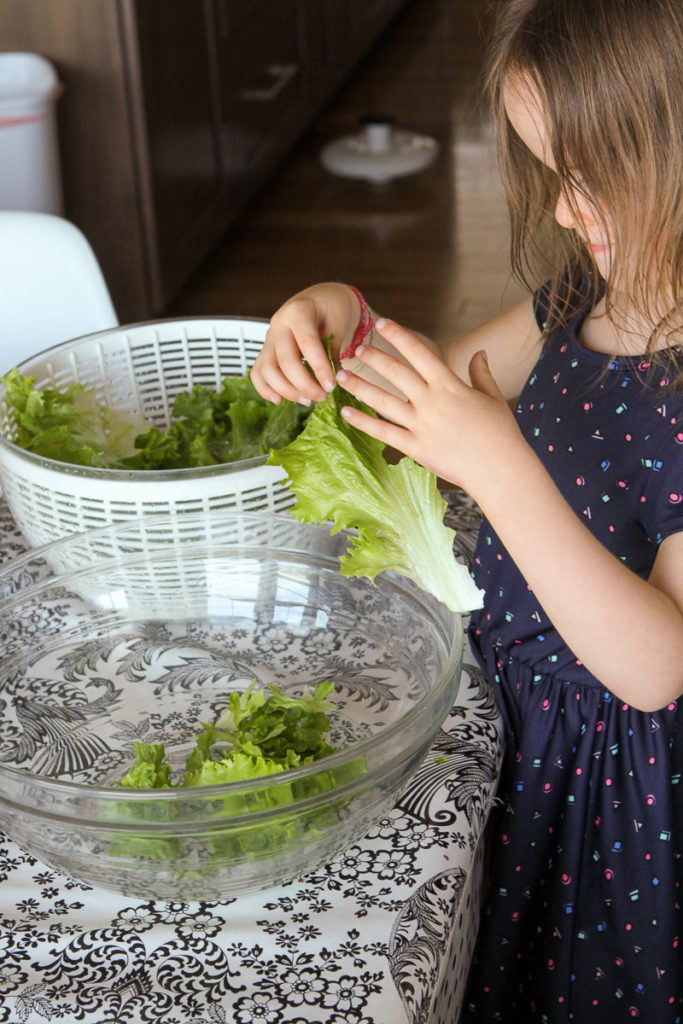
By 8, they are definitely washing and chopping vegetables and fruits for snacks for themselves and younger siblings. The time investment in involving them pays off down the road, as my 12 year old can pull together a meal with very little help. They’re also familiar with all the things we buy, so they are helpful at the grocery store in picking out produce and filling up our cart.
Don’t feel guilty for getting your kids to help! They are more likely to enjoy the meal if they pitch in. Plus, it gives them important life skills and a sense of contribution and competence that they find satisfying (even if they grumble a bit.)
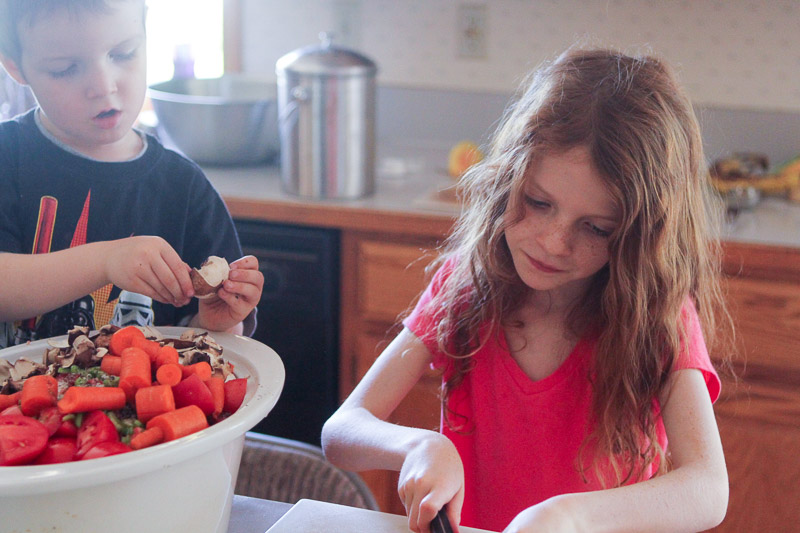
I just ordered these crinkle cutters so my littler kids can get in on the chopping action.
Also, employ your kids to help clean up after the meal. (Literally employ them if you pay for chores. They’re cheap help!) We all know the dishes and counter wiping add up to extra time in the kitchen. We turn on fun music and clean up as a family. Our 8 year old can do all the dishes except sharp knives and heavy pots, even while the toddler “supervises.”

It might be tempting to put off healthier cooking until you’re less busy (AKA when your kids are leaving the house), but involving them and modeling this lifestyle is an invaluable gift they will take with them and use as adults. You can change your family’s food culture with your kids alongside.
If you aren’t sure where to begin with teaching kids to cook, or you want them to take a self-guided course, I can recommend the Kids Cook Real Food course (affiliate link). Just the section on teaching kids how to safely handle sharp knives won me competent veggie choppers in a hurry! Specifically it taught them technique and catch phrases around how to handle knives that we are still using years later. I can tell my kids “up and over soldier” and they immediately switch their grip on the food they’re cutting.
3. Get kid-free and get hustling!
As an alternative strategy, some moms swear by having the kids occupied with their own pursuits right when the groceries arrive. Then mom (and dad?) can wash, chop, and prep right then when she & he can be most efficient.
I also know other moms who save screen time for the pre-dinner hour so they can move faster to get things on the table.
4. Dramatically simplify your menu
One mom says she sticks with fruit and whole grain granola and plant-based milk or toast with a nut butter for breakfast . That’s every breakfast at her house during this season in her family. It’s dramatically healthier than eggs or poptarts, it’s plant-based, and yes it “counts!” It may not be glamorous, but you can vary the fruit and having a standard breakfast would free you up to devote more brain cells to what you have for dinner.
5. Embrace your time limitations
For the other meals, the same simple-breakfast mom basically makes what she can in an hour a day, which for her means dinner falls under the category of vegetable broth-based soup, healthy pasta and vegetable dishes, veggie burgers with whole grain buns, lentil tacos, and chickpea dishes. That hour would include soaking beans for the next day, sticking some sweet potatoes in the oven for lunches later in the week, etc.
Another mom says she only makes dinners she can prepare in less than 30 minutes. It’s doable if you keep gathering recipes that work for you.
My black bean soup takes 15 minutes and it’s a regular around here.
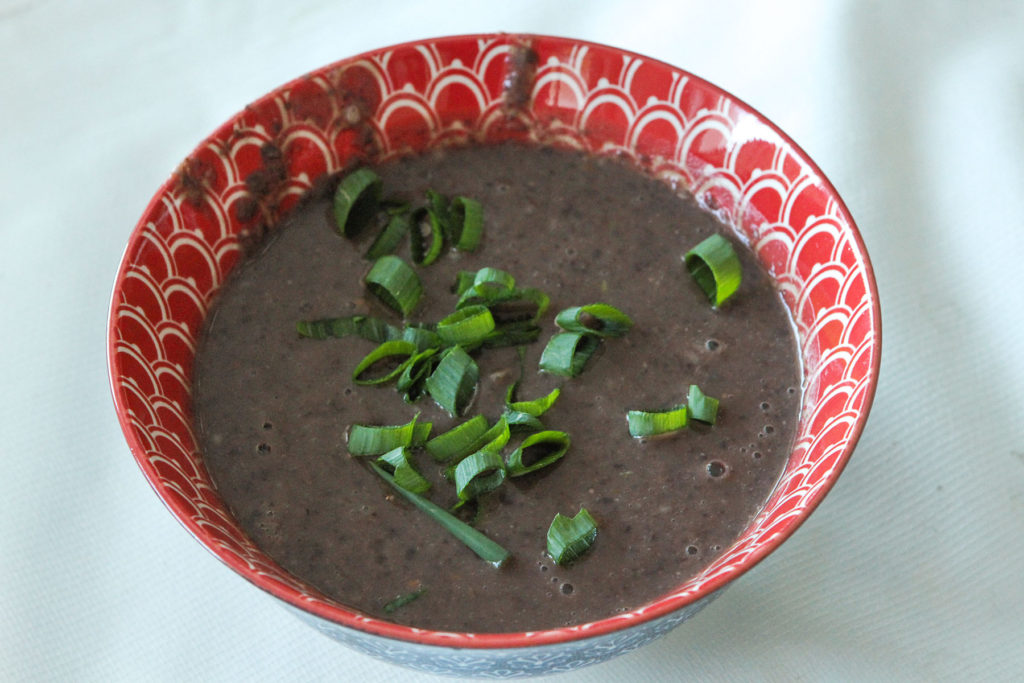
6. Meal Plan
If you don’t already do this, I would encourage you to try it for several months. It saves lots of stress and scramble, not to mention reducing trips to the store and increasing your efficiency when you can look ahead and prep for a future meal. (If you want help making a once-a-month menu plan, here it is.)
7. Find like-minded inspiration online
If you find yourself spending a lot of time looking for recipes and a lot of time making meals that don’t turn out, this tip may be one to try.
It can be hard to gather fast recipes if you’re trying to start from scratch every time you search for meal ideas. If instead you can follow someone who tends to make simple recipes you like, it can be a gold-mine for quick meal ideas and very encouraging as you improve your family’s diet.
Plantiful Kiki on YouTube is one like that for me! And when I discovered Shane and Simple, I quickly found a half dozen go-to recipes to add to our regular meals. Rather than jump around to different blogs and get hit-and-miss results, try sticking with one.
8. Eat oatmeal for breakfast
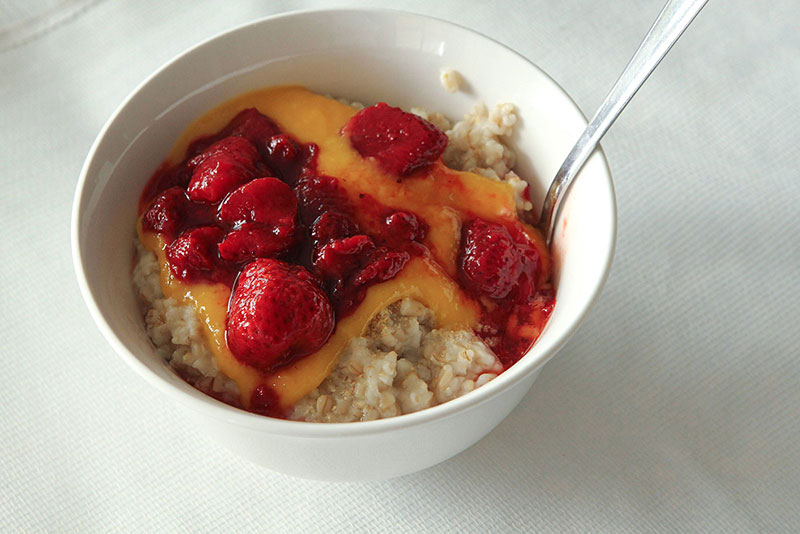
It’s fast, filling, and easy to vary for seasons and taste preferences. Yum.
9. Make a pot of soup for lunches
Some moms make up a pot of soup on Sunday and serve it all week long, rounding it out with fruit and veggies for lunch.
10. Banish side dishes
Many of us grew up with a main dish of meat and at least one or two side dishes for dinner. But guess what? When vegetables ARE the main dish, you don’t need to prepare main course AND a side salad. It’s fine to do that, but it’s also fine to serve a one-dish wonder like I do most nights.
11. Simplify with roasted vegetables
If you do like a veggie side, several moms swore by simply tossing chopped fresh veggies (broccoli, asparagus, zucchini) or even frozen veggies (cauliflower, broccoli, brussels sprouts) straight on a parchment paper lined sheet pan with some olive oil and salt and pepper. They roast for 10-20 minutes at 400F and make a delicious dish with minimal effort.
You’re aiming for a little bit crispy, but before they burn.
(I need to try frozen because although that saves chopping time, I am wondering if they will crisp up? We loooove roasted fresh veggies though.)
Bonus: Leftovers can be scrambled up with tofu or cooked with hashbrowns for breakfast the next day.
12. Double (or triple) recipes whenever possible
Leftovers are truly a free (from prep-time) lunch… or dinner. You save time with clean-up, planning, shopping, and prepping when you make the same dish stretch for several meals.
If you have a family of leftover objectors, change up the leftovers a bit to make them more appealing. Wrap them in a tortilla or take the time crisp a veggie burger up in a pan instead of just nuking it in the micorwave.
13. Try it in the freezer
We often depend on someone else to tell us if something freezes, but it’s pretty easy to just set aside a single portion, freeze it, and have it for lunch in a few weeks. Then you can mark your own recipe to indicate whether it freezes or not. You have hardly anything to lose, and lots to gain. Freezing meals helps inject variety into your future menus without complicating prep and shopping, and like leftovers, a freezer meal is a “free” lunch or dinner.
My general rule of thumb is that we will happily eat frozen soup or anything we ladle over rice, as long as it doesn’t have potatoes or sweet potatoes. We aren’t a big fan of the texture of those after they’ve been frozen. (Think chili, lentil soup, chickpea curry, enchilada casserole, etc.) Also, I’ll sometimes leave out leafy greens from the part I freeze and add them when I re-heat the meal. Fresh cilantro, for example, will really brighten up a meal that’s been defrosted.
I have nice big pans so I can triple a meal, and have it last for 2 dinners and a lunch, with a frozen dinner to pull out the following month.
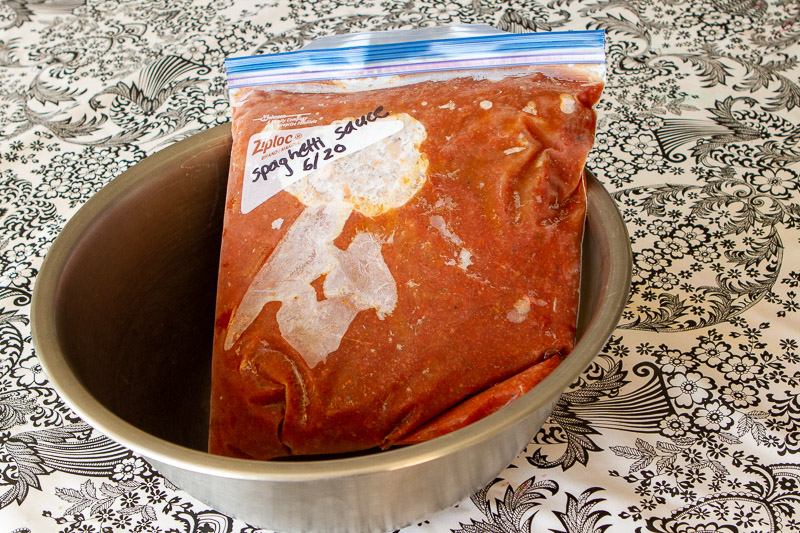
14. Batch cook for the freezer
Some recipes can be frozen easily and don’t lose flavor or texture when thawed, even after many months. I will periodically make a BIG batch of something and freeze several extra bags of it for the following months.
Example: When I make roasted tomato pesto in the summer time when fresh basil and tomatoes are easy to come by, we’ll eat it for dinner one night, but I’ll put 6-8 bags of the sauce in the freezer and we’ll eat it once a month in the fall and winter.
We often eat muffins one morning a week for breakfast, but I only make muffins (and mess up the bowl and muffin tins) every 5-6 weeks and I fill freezer bags for subsequent weeks.

15. Buy pre-cut fresh or frozen
Frozen fruits and vegetables are picked at their peak and free of preservatives. They’re a great option for when you’re feeling tight for time, though sometimes you pay extra for the convenience.
Butternut squash cubes, shredded carrots, chopped onion, fresh or frozen stir fry blends, shredded broccoli slaw, guacamole… there are lots of good options and all are time-savers!
16. Get in the habit of prepping the whole thing
If you’re slicing up some cucumber for lunch, slice the whole thing up for the next few days. Ditto a box of strawberries or an onion. Do a couple extra so you don’t have to pull out the cutting board every day.
Think, “What else can I chop, as long as I’m chopping?” and picture yourself a karate master honing your mad chopping skills. Ha!
17. Choose a menu that carries over ingredients
I loved this example from Rainbow Plant Life on YouTube:
She re-uses ingredients in multiple meals so weekend meal prep is under two hours, but there’s variety during the week. There’s no need to re-invent the wheel, and you can totally use some of her meal plans. But as you build your own list of meals your family likes, you can also just look for ones that group well together for easier prep because they have overlapping ingredients.
18. Invest some time in learning
Not a karate chopping master yet? Maybe your knife skills are weak, you haven’t ever figured out how to use that Instant Pot, or the food processor intimidates you. Sometimes the best way to speed up is to slow down and master some basic skills that will continually help you. I highly recommend watching some YouTube videos and practicing. I changed the way I chop sweet potatoes and it takes 1/3 of the time now! (I used to slice into rounds first, now I chop long sticks first.)
19. Get a good chopping knife and a sharpener
An excellent knife makes a tremendous difference in speed. You can find a good one for less than $30, which blows my mind, and my husband swears by this inexpensive knife sharpener.
If you’re limping along with sub-par tools, recognize that cooking at home (efficiently enough so you aren’t ordering take-out as a last resort on the regular!) saves so much money.
20. Use your food processor!
Lots of people have one just gathering dust, and this appliance can speed up prep time considerably. This is especially true if you run several meals worth of veggies through there at a time.
You’ll quickly get the hang of putting it together and taking it apart, and don’t be intimidated by the time it takes to wash up afterwards. If you do it promptly, and you’re not using oil, a quick rinse easily takes care of the mess.
21. Choose chop-free snacks
Rinsing blueberries takes seconds, bananas come with an easy to remove wrapper, snap peas are ready to go, baby carrots are fuss-free, etc.

Frozen peas are a favorite here. (PSA: Use defrosted peas for toddlers and for heaven’s sake don’t let them walk around eating a choking hazard (like I sometimes do, apparently)! Always consume at the table.)
22. Get a jump on dinner the night before
If you can pull something out of the freezer, get some quick chopping done or ingredients measured out the night before, things will go much more smoothly the next day! You’ll have your plan in mind and the initial momentum already going. A few minutes of preparation can save you from the desperation drive-through.
23. Fill kids up on intact starches
They’ll be less munchy all day if they’ve had meals with plenty of brown rice, sweet potatoes, oatmeal, quinoa, etc. Sometimes people new to this way of eating don’t eat nearly enough at mealtime, so they feel the need to graze all day long. That leads to a messy kitchen and constant requests for snacks. Encourage everyone to eat plenty at a meal and then clean up and give yourself and your kitchen a break.
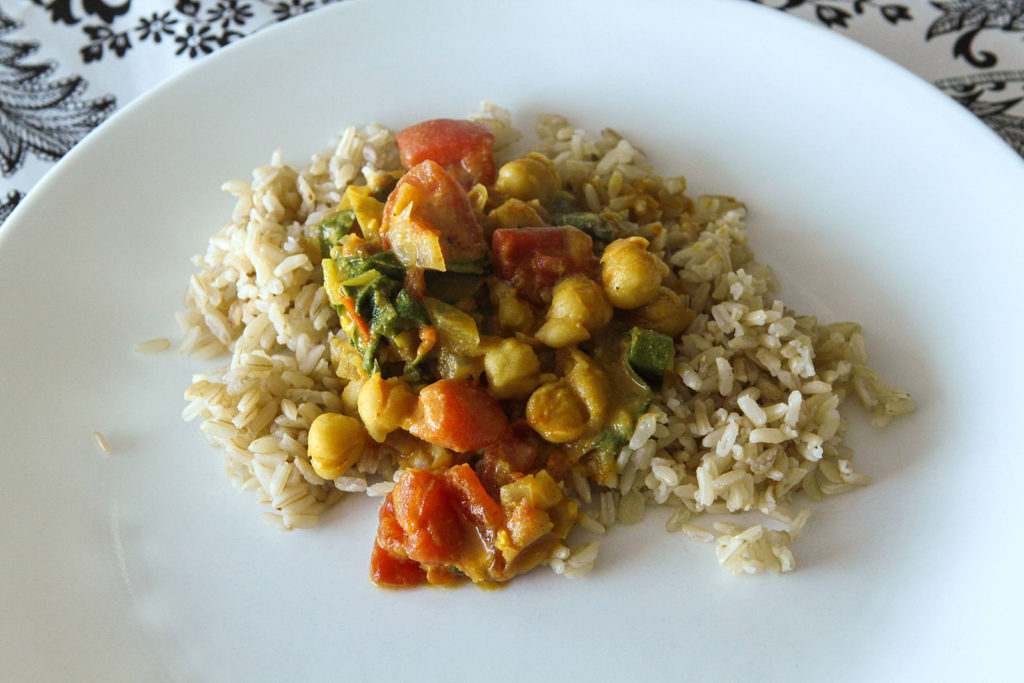
24. Stay the course
Many moms expressed how much more efficient and comfortable they got after they had been feeding their families this way for a while.
25. Find your own balance
Each of us will find the areas where we choose to compromise (store-bought tortillas, a regular dinner out, store-bought hummus, simpler recipes, etc.) to make this workable for our families.
Don’t let perfectionism prevent you from making positive change!
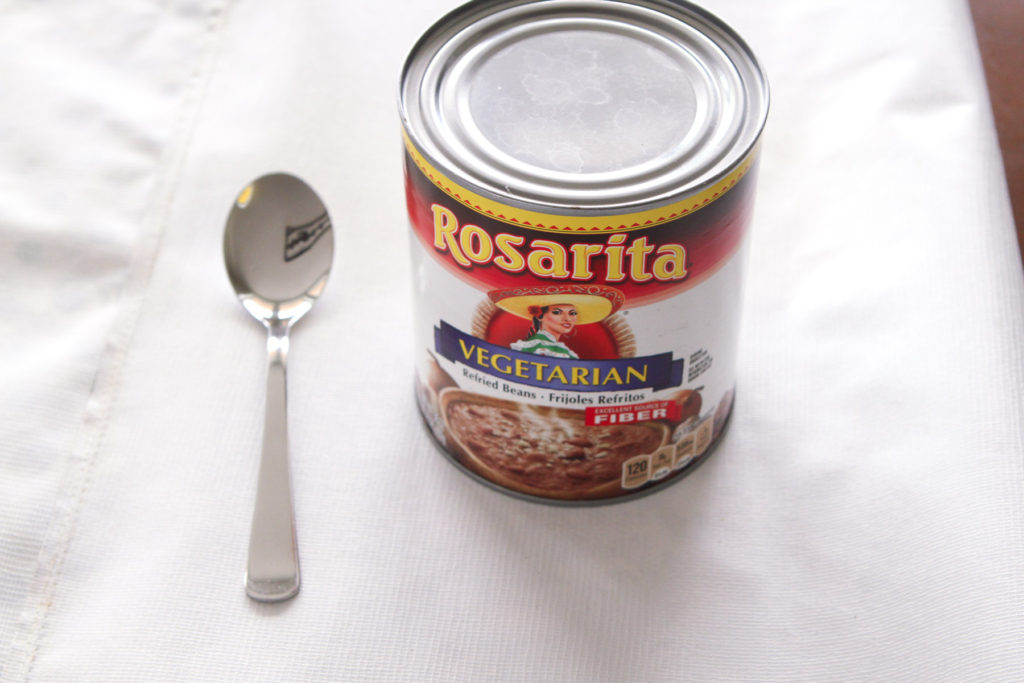
26. Funnel time to the kitchen
There is a lot you can do to streamline your time in the kitchen, but you may need to spend less time in other areas in order to devote some time to cooking. Moms are constantly juggling different priorities.
Personally, I have lower standards in some areas to allow me to make healthier food for my family. I don’t fold my little kids’ clothes (or washcloths or rags…) , I let my kids do chores around the house and call it “good enough,” I rarely (almost never) wash windows, etc.
27. Make kitchen time count for double
Time in the kitchen can be made much more pleasant and/or productive.
Why not:
- Listen to podcasts or an audiobook
- Call a friend or a parent
- Catch up on Youtube
- Listen intently to any kid that stops by to chat
- Enjoy one-on-one time with a kid who is your kitchen helper for the week
- Just relax and listen to music you love.
If the pre-dinner hour is chaotic in your house right now with a fussy baby or melting down older kids, I highly recommend making use of a more peaceful block of time to prep and cook. Nap time, night time, while your kids are happily eating lunch, on the weekend, or while your husband reads to them during dinner… any of these times are good candidates to take pressure off you to cook during The Witching Hour.

Where is Mama when this picture was taken? Ok, I was behind the camera but before and after I was enjoying listening to my husband read while I put on some hustle in the kitchen, throwing things in the Instant Pot so dinner would be all taken care of.
28. Don’t discount clean-up time!
For a long while I was perplexed at how I could get dinner on the table fast, but I was still spending “forever” in the kitchen. Then I realized I as moving so fast that I made a major mess to deal with after dinner. This deserves a whole post, but for now just consider that all the wiping and washing is a factor as well, so, for example, using fewer pots and pans can help.
29. Check your facts
One of the most helpful things I’ve done to make my kitchen time more efficient is to simply use a kitchen timer (or the stopwatch on my phone) to time how long different tasks and dishes make.
How long does it really take me to peel and chop a butternut squash? I only have to tap a button one time and I can find that out. That information can then inform whether I want to buy that vegetable pre-chopped or perhaps even avoid recipes that call for chopped squash in my menu plan, etc.
Using a timer has also let me see which recipes actually can be cooked in the advertised time! I scribble right on my recipe how long it took ME from start to finish.
30. Check your thinking
Your attitude matters a whole lot, so if you find you’re complaining a lot (even to yourself) about time spent in the kitchen, you might try focusing on your gratitude for the mouths you have to feed and for the abundance of healthy food you have to work with.
Just like some of the other mundane parts of mothering, doing it with love feels better.

Help your fellow Mamas out!
Please comment and share how you save time in your plant-based kitchen.

I do a lot of recipe-less meals. We love grain bowls in our house. I cook a grain, then chop up whatever veggies and proteins are I’m the fridge and need to be used up. Everyone gets a bowl with grain, then each person selects what toppings they want (some veggies and at least one protein are required). Then, they just add whichever sauce they want from what we have in the fridge. No whining/complaining, everyone gets what they want, and it uses up the bits and pieces that are trying to migrate to the back of the fridge.
Great job as usual! Even with a smaller family I can use these tips. Thanks so much.